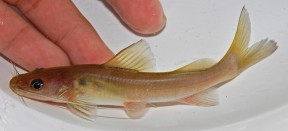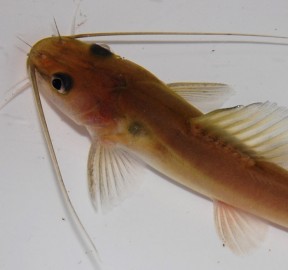Hemibagrus planiceps
SynonymsTop ↑
Bagrus planiceps Valenciennes, 1840; Bagrus anisurus Valenciennes, in Cuvier & Valenciennes, 1840; Bagrus flavus Bleeker, 1846; Macrones planiceps (Valenciennes, 1840); Mystus planiceps (Valenciennes, 1840)
Etymology
Hemibagrus: from the Greek hemi, meaning ‘half’ and the generic name Bagrus.
planiceps: from the Latin planiceps, meaning ‘flat-headed’.
Classification
Order: Siluriformes Family: Bagridae
Distribution
Type locality is ‘Java, Indonesia’, and this species is known only from the Ciantern, Cidurian, Cikeas, Ciliwung, Cimanuk, Cisokan, and Citarum River systems in western Java.
Habitat
Occurs in the upper parts of river basins, displaying a preference for clear, fast-flowing habitats with substrates of rocks or sand.
Maximum Standard Length
The largest officially-recorded specimen measured 263 mm.
Diet
Probably a predator feeding on crustaceans and smaller fishes, although there should be no need to use such live foods in captivity.
Sexual Dimorphism
Males possess an elongate genital papilla which reaches the anal-fin origin.
NotesTop ↑
This species is now considered endemic to Java but has been confused with the congeners H. gracilis (from eastern Peninsular Malaysia), H. velox (Sumatra) and H. bongan (Borneo) in the past, while the population formerly considered to inhabit northwestern Peninsular Malaysia has been described as H. divaricatus (Ng and Kottelat, 2013).
Hemibagrus has been divided into a number of putative species groups which may or may not represent monophyletic assemblages, and following a major review by Ng and Kottelat (2013) H. planiceps is included in the H. planiceps group.
Members of this assemblage can be told apart from other congeners by possession of 47–51 vertebrae, a short adipose-fin base (less than 20% SL) and with the body lacking a dark midlateral line.
Currently valid members are H. bongan, H. divaricatus, H. gracilis, H. lacustrinus, H. planiceps and H. velox.
H. planiceps can be distinguished from other group members by possessing from relatively fewer vertebrae (47–49, mode=47 vs. 48–50, mode=49 in H. bongan; 51 in H. divaricatus; 50–52, mode=52 in H. gracilis and H. velox; 49–50, mode=49 in H. lacustrinus) and a greater interorbital distance (32–37% HL vs. 28–34).
It further differs from others in the group, except H. lacustrinus and H. velox, in possessing shorter maxillary barbels (148–220 % HL vs. 199–283).
It also has a longer adipose-fin base (15.5–20.6 % SL vs. 11.1–15.5) and shorter dorsal spine (8.2–12.4 % SL vs. 12.3–12.9) than H. divaricatus, and a shorter pectoral spine (10.0–16.5 % SL vs. 15.0–16.7) and longer dorsal to adipose distance (12.0–17.3 % SL vs. 7.6–10.9; adpressed dorsal-fin not reaching vs. reaching origin of the adipose fin) than H. lacustrinus.
It can be further distinguished from H. gracilis and H. velox in possessing a deeper caudal peduncle (7.1–8.6 % SL vs. 6.2–7.6), from H. gracilis in possessing a longer snout (33–40 % HL vs. 30–35) and from H. velox by possessing a rounded (vs. gently tapering) upper caudal-fin lobe, fewer branchiostegal rays (8–10 vs. 10–11), and by males possessing a relatively short genital papilla (not reaching anal-fin origin, vs. reaching)
The genus Hemibagrus currently contains 40 nominal species which are distributed east of the Godavari River system in India and south of the Changjiang (Yangtze) drainage in China, with Southeast Asia a particular centre of diversity.
Many species are important food fishes and some are cultured for the purpose, or for sport angling.
Hemibagrus has previously been considered synonymous with Mystus but following Ng and Kottelat (2013) members can be diagnosed by their moderate to large adult size and strongly-depressed head shape with the interorbital region normally flat or slighly convex.
The grouping also shares a number of characters with the genera Sperata and Bagrus, and these three can be separated from other bagrids by the following: mesethmoid highly depressed (vs. not highly depressed), prominent (vs. reduced) dorsoposterior laminar extension of the mesethmoid, the first infraorbital with (vs. lacking) a posterolateral spine, enlarged (vs. moderate or small) premaxilla, and the metapterygoid with a long, free posterior margin (vs. contacting quadrate and hyomandibular).
Hemibagrus can be told apart from Sperata by possession of a a relatively short and slender (vs. enlarged and elongate) interneural and by absence (vs. presence) of a concave surface in the posterior portion of the posttemporal in which lies a portion of the swimbladder.
It’s distinguished from Bagrus by possession of 7, very rarely 8 (vs. 8-10) soft dorsal-fin rays.
References
- Cuvier, G. and A. Valenciennes, 1840 - Pitois-Levrault, Paris. v. 14: i-xxii + 2 pp. + 1-464 + 4 pp.
Histoire naturelle des poissons. Tome quatorzième. Suite du livre seizième. Labroïdes. Livre dix-septième. Des Malacoptérygiens. - Ferraris, C. J., Jr., 2007 - Zootaxa 1418: 1-628
Checklist of catfishes, recent and fossil (Osteichthyes: Siluriformes), and catalogue of siluriform primary types. - Ng, H. H. and I. Rachmatika, 1999 - The Raffles Bulletin of Zoology 47(1): 167-183
The catfishes (Teleostei: Siluriformes) of Bentuang Karimun National Park, West Kalimantan, Indonesia. - Ng, H. H. and M. Kottelat, 2013 - The Raffles Bulletin of Zoology 61(1): 205-291
Revision of the Asian catfish genus Hemibagrus Bleeker, 1862 (Teleostei: Siluriformes: Bagridae). - Ng, P. K. L. and H. H. Ng, 1995 - The Raffles Bulletin of Zoology 43(1): 133-142
Hemibagrus gracilis, a new species of large riverine catfish (Teleostei: Bagridae) from Peninsular Malaysia. - Roberts, T. R., 1993 - Zoologische Verhandelingen (Leiden) No. 285: 1-94
The freshwater fishes of Java, as observed by Kuhl and van Hasselt in 1820-23. - Tan, H. H. and H. H. Ng , 1999 - Journal of Natural History 34(2): 267-303
The catfishes (Teleostei: Siluriformes) of central Sumatra.





